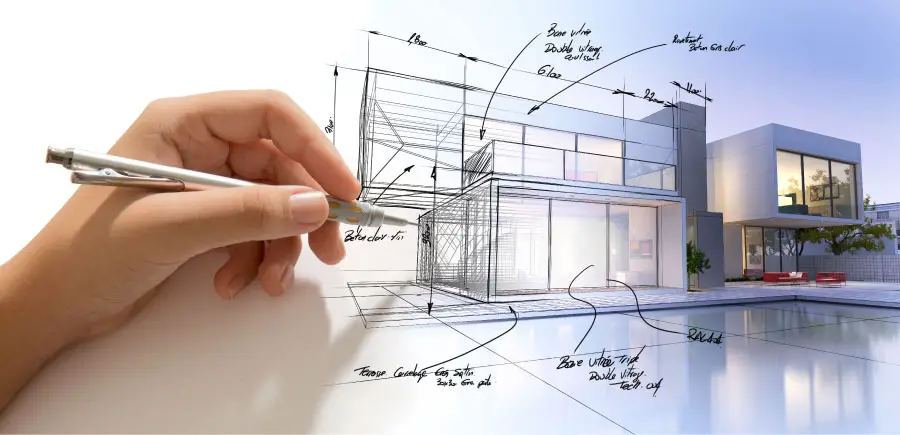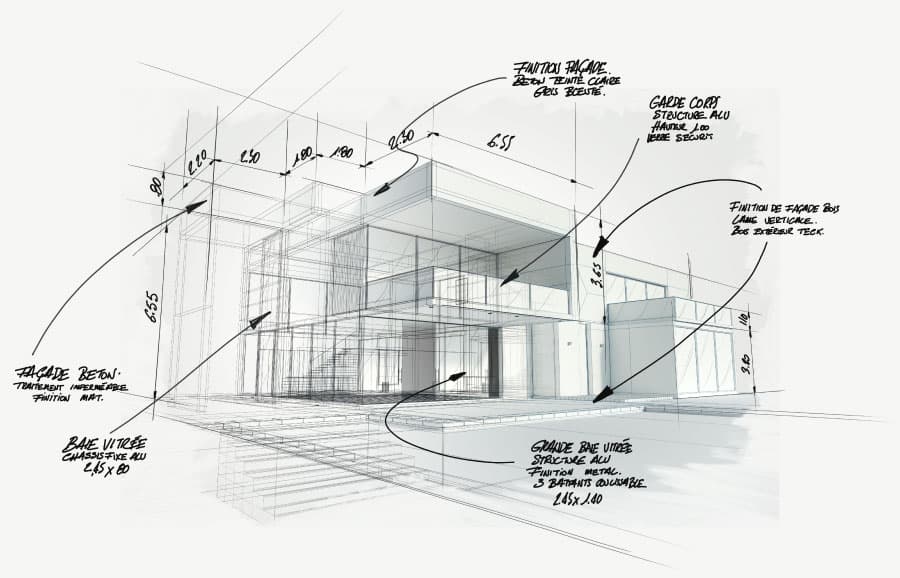What Genre of Architecture Does the Drawing Show

I am always surprised at the number of people who ask me whether you need drawing skills in order to become an architect when they find out I am studying architecture.
Does architecture require drawing skills? Yes, at least some drawing skills are required to perform well in the architectural field. Both as a student and a professional, an architect is required to express his/her ideas through a visual medium. Architecture plans, ideas, and presentations require drawing skills.
Although that may sound simple enough, there are a few things worth looking into on a deeper level like what kind of drawing skills architects need, what architectural drawings look like, and also what you can do to improve your drawing skills for architecture.
What if I can't draw? Can I still become an architect?
Yes, there is no reason why a lack of skill in drawing should prevent you from pursuing your dreams of becoming an architect.
Drawing is a skill, and as such, it can be developed by anyone. Aside from that, all you need is a pencil and a piece of paper, so it should be easy for you to practice regularly.
One of the biggest misconceptions that new students have is that all their drawings, even the sketches, need to look good. If you search the sketches of famous architects while they were conceptualizing for a project, you'd be surprised to find out that most of them look like a bunch of non-cohesive lines put together.
It will be challenging ar first. A big mistake that new students make in architecture school is comparing their work with their peers and getting disheartened when their work doesn't look as good. However, with hard work and perseverance, you will eventually be able to catch up perform better.
Drawing is usually only emphasized in the earlier years of architecture school for a student to build a good foundation in translating their ideas into drawings. Later down the line, professors focus more on developing a student's ability to use Computer-Aided Drawing(CAD) software. Drawing with CAD takes a while to get used to because it's different from conventional drawing.
Here's a quick rundown for CAD. You draw along an axis line and usually type out the dimensions and angle of a line to form 2D drawings. And for modeling, you work by creating surfaces on a 3rd plane.
Later into the article, we'll be going into why drawing is still needed despite this heavy shift to CAD software.
What do architects and architecture students draw?
Here is the list of things that architects and architecture students will have to learn how to draw manually.
- Plans (Site development, Floor plan, Structural, Electrical, Plumbing and etc.)
- Perspectives
- Elevations
- Sections
- Details
The list goes on and on depending on the needs of a certain project.
What is architectural drawing?
Architectural drawing is a standardized method of drawing, to express ideas so that others may understand them, and to convey important information about the project. Certain symbols, elements, line weights, and hatching provides a clearer picture for your client or the people you're working with and an easier way to understand your intent for a building.
Architectural drawings are NOT just drawings, treat it as a literal representation of the building. A missing line, misuse of a symbol, or an improper measurement on an architectural drawing can cause problems ranging from minor inconveniences to the total reconstruction of a project. Remember that architectural drawings are also legal documents.
To avoid missing details on architectural drawings, ensure that you are well-informed of the requirements and how things are actually built. For example, have you ever noticed that bathrooms are usually a bit lower compared to the rest of the floor or perhaps the small width difference of a door frame and a wall?
At first, professors won't expect you to have thoroughly detailed plans, but in later years, they will not hesitate to call it out if you present a plan with missing details.

Architectural drawing with CAD vs manual drawing
Before computers became accessible to everyone, architects and architecture students had to draft everything manually. These days most firms use CAD produced drawings when presenting or submitting plans. However, this does not mean that developing the skill for manual drawing/drafting is utterly useless for architecture students, and here's why.
- Drawing is faster for visualizing ideas and concepts compared to CAD.
- Drawing allows you to edit easily; all you need is an eraser.
- Drawing allows you to add your own little details and specifics.
- Drawing can be done anywhere, useful for documenting moments of inspiration.
- Drawing has limitless possibilities, instead of being contained in the limits of the software.
Are drafting drawings required in architecture?
Depending on your architecture school, your curriculum may include manually drafting drawings.
- Drafting, in itself, is a method of creating architectural drawings with the utmost attention to detail, accuracy, consistency, and capability to convey information.
- Before computers, drafted architectural drawings were what architects would submit to governing bodies, engineers, and clients for approval.
- Drafting often requires every pencil/pen stroke to be assisted by measurement tools, and every line on the sheet must be measured and appropriately scaled.
- Drafting requires precision, care, planning, and willpower. Doing a draft of one sheet full of drawings requires a bare minimum of 4 hours of productive work.
- Drafting is very dependent on the details. Even simple lettering requires you to use your triangle and T-square to ensure that all the lines in each letter is straight and draw guidelines to ensure that all letters are the same height.
- Drafting is more than just creating a detailed drawing. It also requires compostioning, as you'll need to manually position each element of the plan and each element of the sheet.
What can you do to improve your drawing skill for architecture?
- Practice your lines. This may sound boring, but by practicing how you draw your lines, you'll gain confidence and a cleaner finish. Think of it like practicing how to dribble for basketball, it's fundamental.
- Don't be afraid to get messy when coming up with ideas. You'll notice if you google "architecture concept drawings" how messy lines really are. Lines are everywhere, the shading isn't consistent, etc. The purpose of this type of drawing is simply to express an idea and see what it would look like.
- Start simple, then add the details. All drawings always begin with a general shape before any other additional details. A common mistake that people learning to draw often make is that they attempt to add details immediately instead of slowing getting into it. Many times you'll have to adjust your drawing to get your plan to work, and it doesn't help to keep on adding details that you'll end up erasing.
- Proportion and scale. When doing architectural drawings, even if it's just doodling ideas, it's always a good practice to draw things in proportion to one another. The average door is always around 2 meters tall, and a storey is usually 3 meters from floor to ceiling. Use these common measurements so that the other objects in your drawing won't look weird, too big/small, or out of place.
- The vanishing point. In architectural perspectives, there will always be vanishing points. It could be one vanishing point or two vanishing points. Vanishing points are meant to replicate how our eyes perceive depth and the details that go along with that. Vanishing points are essential to get a general perspective on how your building will appear from a person's point of view.
- Line weights. The importance of line weights cannot be stressed enough. Line weights are what's used to differentiate objects and highlight their importance in a drawing and is a requirement for any architectural drawings.
- Mind your pencils. Get a decent set of pencils with a varying density of lead. The type of lead indicates the darkness of the lines they produce, classified as either B, HB, F, or H (arranged from darkest to lightest). You might think you can get away with just pressing the pencil harder against the paper, but the difference between a B-pencil and an H-pencil is night and day.
- Get the right pen. Please do not use a ballpen or a fountain pen when doing manual drawings/drafting. A technical drawing pen is the standard pen used by architects and engineers. Technical pens tend to be expensive compared to your regular pen; however, they provide a more consistent line width, weight, and shape.
- Measuring Tools. T-squares, rulers, triangles, french curves, and templates are going to be your best friends when creating drafts. These tools ensure that your lines are always correct, to scale, and consistent.
Conclusion
Architecture and drawing are inseparable from each other. The architectural field is reliant on communicating and translating ideas as well as conveying the necessary information and details, through visual means.
Drawing is the most effective and straightforward way to express an object; in our case, a structure. A common misconception is that creating plans is the longest/hardest part for an architect working on a project when, in reality, it's actually the design process.
As a student, professors will require you to constantly submit outputs that show how you envision your project to turn out. The same way that writers create hundreds of drafts before publishing a book, an architect creates hundreds of drawings before arriving at a final design.
Source: https://whatblueprint.com/does-architecture-require-any-drawing-skills/
0 Response to "What Genre of Architecture Does the Drawing Show"
Postar um comentário